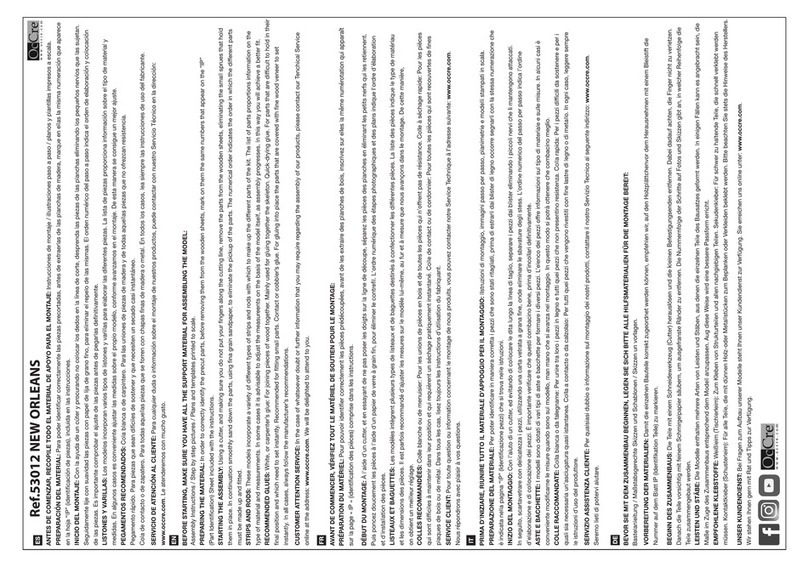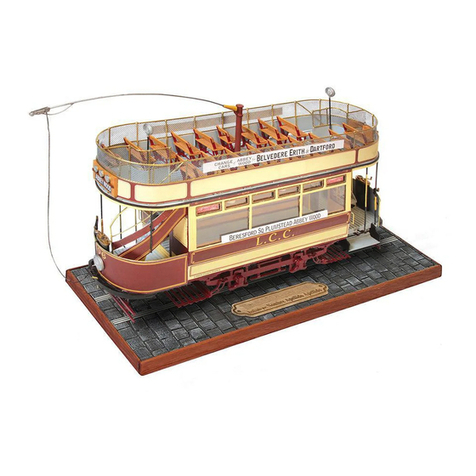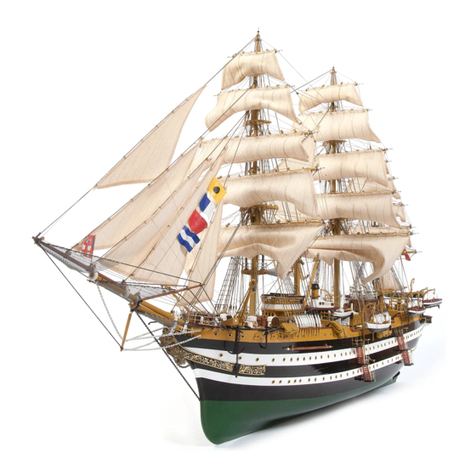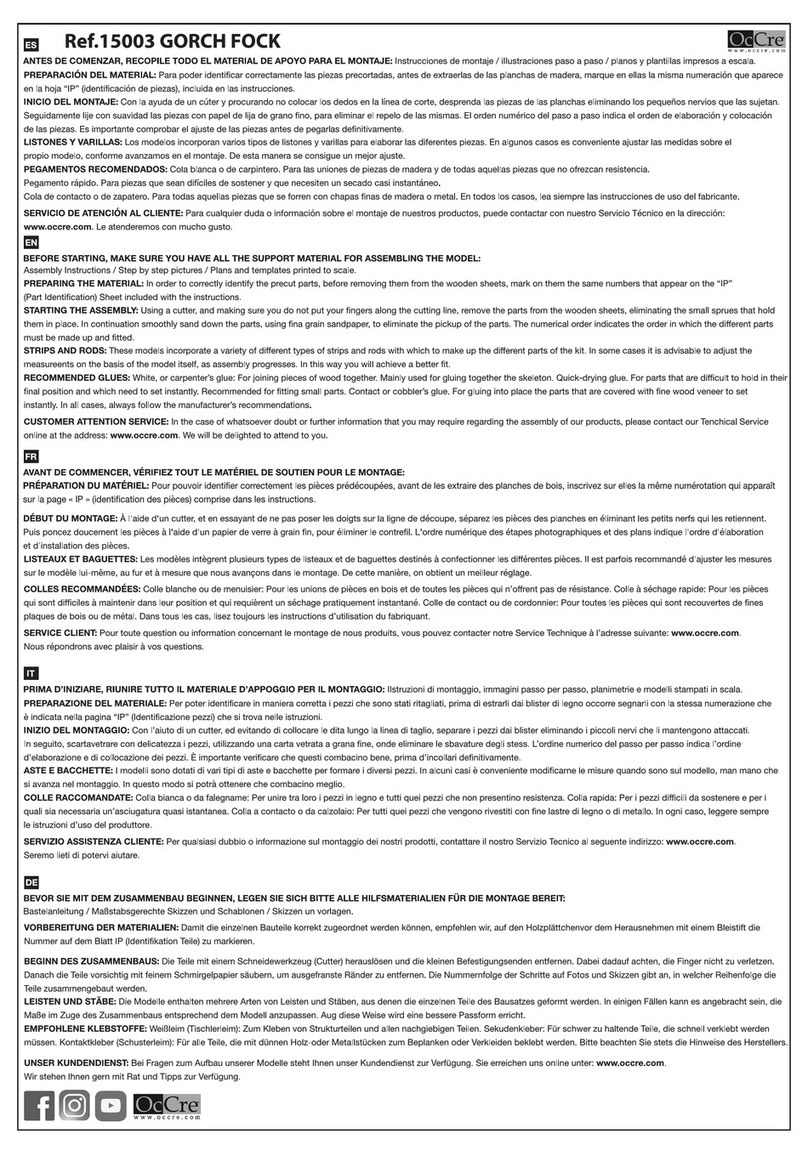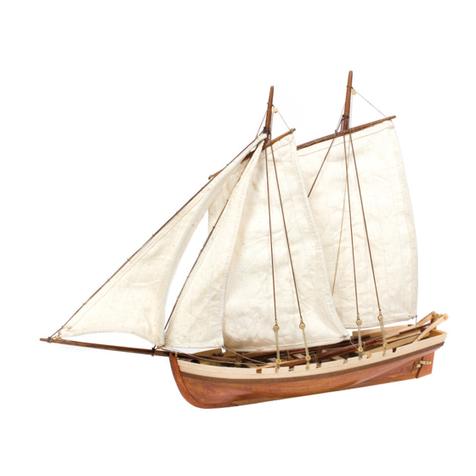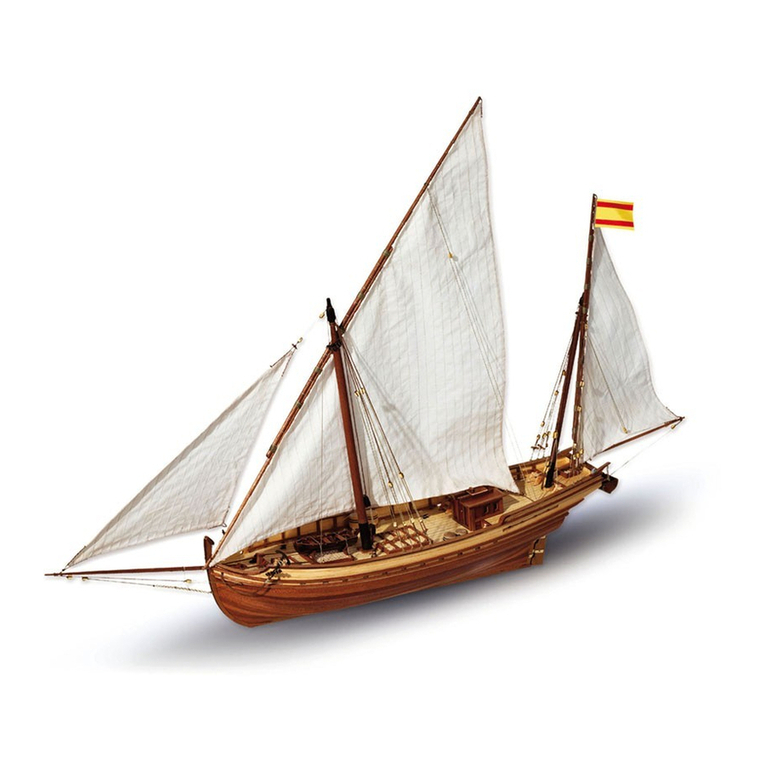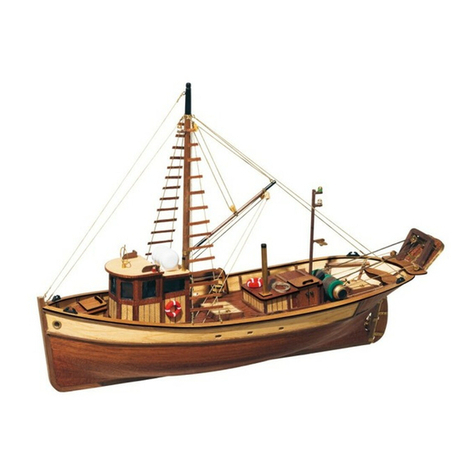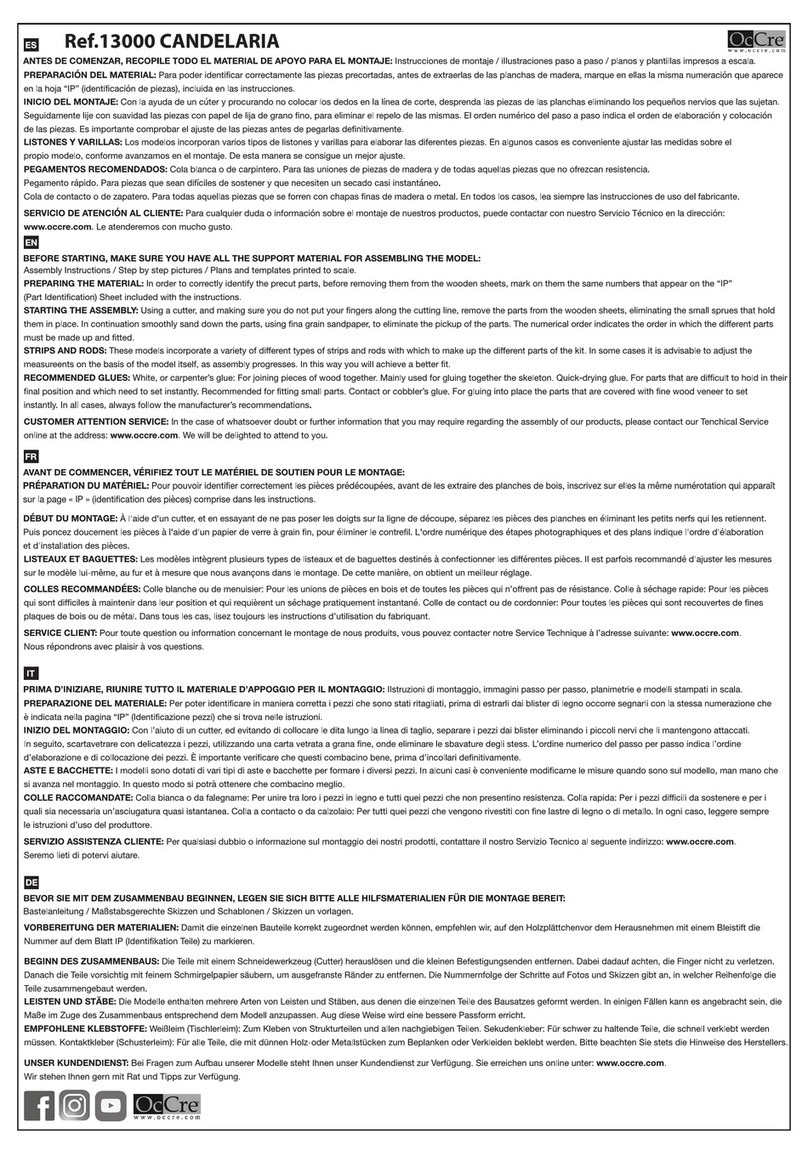INSTRUCCIONES DE MONTAJE PRINZ EUGEN
A-B-C. Utilice una superficie plana y estable para pegar las piezas A1 y A3, y refuerce su unión con las piezas A2 y A4. Siguiendo el orden alfanumérico inserte y pegue las piezas indicadas
en las figuras. Antes de encolar las cuadernas, verifique que encajan correctamente en su posición haciendo “tope” en los encajes correspondientes de la falsa quilla. Es importante que las
cuadernas queden completamente perpendiculares a la falsa quilla para que posteriormente encajen bien las cubiertas. Para esta operación utilice como adhesivo cola blanca, (Ref.19200).
D. Corte a medida y pegue los refuerzos D1 y D2. Utilice un cúter para desbastar los refuerzos. Trace una línea longitudinal que divida la cubierta D3 en dos mitades. Después, trace líneas
transversales cada 30mm empezando desde la parte delantera de la cubierta. Pegue las cubiertas sobe la estructura y dé continuación a las líneas hasta llegar al final de la estructura. Para
esta operación utilice como adhesivo cola blanca, (Ref.19200).
E. Corte las tiras de forro y destaque sus cantos con un lápiz. Comience a forrar la cubierta ajustando la primera chapa a la línea de lápiz que le indica la imagen. Pegue las chapas muy
juntas para que no se noten las uniones. Utilice como adhesivo cola de contacto, (cola de zapatero). Frote las chapas contra la cubierta para que se adhieran con firmeza. Después, corte
los sobrantes de las chapas con un cúter. Lije la cubierta hasta dejar su superficie fina y homogénea. Después, elimine el polvo resultante del lijado y aplique un par de capas de barniz
satinado, (Ref.19209), lijando entre una y otra.
F. Recorte las figuras F1 y péguelas en la última cuaderna del esqueleto. Coloque el casco boca abajo y comience a lijar empezando desde popa y avanzando hacia proa. Debe desbastar
los refuerzos y las aristas de las cuadernas pero sin deformar su forma original. Debe lijar hasta llegar a las curvas de las figuras F1. El lijado del casco ha de quedar simétrico, es decir, que
el lateral derecho ha de quedar igual que el izquierdo. Para la zona media del casco, utilice un taco lijador con mayor superficie. El lijado debe ser progresivo y suave. En la zona de proa,
comience lijando desde proa y avanzando hacia popa. Compruebe con un listón, que el lijado es correcto. Para ello, debe deslizar el listón, sobre las cuadernas, para ver como se ajusta a
su forma.
G-H-i. Comience el forrado del casco con los listones G1. Si los listones estuvieran muy secos y se le rompen al curvarlos, sumérjalos en agua unos veinte minutos. Con esta operación,
recuperarán flexibilidad. Después, séquelos con un paño. Debe pegar el primer listón desde la proa hasta la cuaderna 11, con cola blanca, (Ref.19200). Después, deberá clavarlo con
puntas A. Pegue otro listón G1 para dar continuidad al primero hasta la parte trasera del casco. Los demás listones del forro debe pegarlos a las cuadernas y entre sí, con cola blanca y
fijarlos con puntas. Continúe pegando listones desde proa hasta popa para forrar el casco entero. Deberá cortar a medida y ajustar las piezas para que encajen en los huecos. Presente las
piezas H2, H3 y H4 en el casco para apreciar cómo debe ajustar el forro. Si en algún punto le ha quedado algún listón suelto, puede aplicar pegamento de secado rápido. Si le ha quedado
algún listón más hundido, pegue otro encima y después, líjelo. Lime las cabezas de las puntas con una lima plana hasta que queden enrasadas con el forro. Diluya un poco de cola blanca
con agua para que pueda aplicarla ligeramente y se filtre entre las juntas de los listones. Reserve el casco hasta que la cola se seque. Con esta operación se unificará el forro del casco
ganando así consistencia. Después, lije todo el casco. Debe quedar suave y sin desniveles.
J-K-L. Aplique cola de contacto, (cola de zapatero), a la zona del casco que le indican las imágenes. Encole y pegue las tiras de forro J1. Debe combinar tiras J1 para completar la longitud
total del casco. Corte a medida las tiras de forro dependiendo de la necesidad. Frote las tiras de forro para que se adhieran con firmeza. Coloque en la cubierta las piezas J2 e inmovilícelas
con cinta de pintor. Estas piezas serán la guía para colocar las piezas J3. Lije una de las caras de las piezas J3 y aplíqueles cola de contacto. Pegue las piezas J3 ajustadas a las piezas J2.
Cuando el adhesivo se haya secado, retire las piezas J2 de la cubierta. Ajuste y pegue las piezas H2, H3 y H4. Después complete el forro del casco y ajústelo a estas piezas. Lije un listón
K4 y sumérjalo en agua para que recupere flexibilidad. Utilice algún objeto cilíndrico para curvarlo. Elabore un gramil con las piezas K5. Marque la línea de flotación al casco con el gramil.
Para esta operación, coloque el casco sobre una superficie plana y estable. Aplique masilla tapa-grietas, (Ref.19143). a todo el casco y cuando se haya secado líjelo, debe quedar fino al
tacto. Repita la misma operación hasta obtener un acabado fino. Aplique imprimación,(Ref.19142). a todo el casco y vuelva a lijar.
M-N. Recorte las plantillas y pegue las porciones obtenidas como le indican las imágenes. Presente las plantillas en el casco e inmovilícelas con puntas A. Utilice un punzón para marcar el
centro de cada orificio en el casco. Después, realice todos los orificios. Proceda de la misma manera en el otro lateral del casco. Inserte y pegue una pieza N1 en cada orificio. Elabore y fije
las piezas N2 en el casco. Para hallar su posición, pegue porciones de cinta de carrocero como le indican las imágenes. Realice los orificios y pegue las piezas indicadas en las imágenes.
O-P. Lije el dorso de las piezas de latón y péguelas con cola blanca, (Ref.19200). Enmascare y proteja la parte superior del casco con cinta de pintor y papel. Pinte la parte inferior del casco
con pintura de color rojo oscuro, (Ref.19383). Para esta operación puede utilizar pincel o bien pintar a spray o aerógrafo. Utilice de referencia el plano a color. Trace otra línea a 36mm de la
base y enmascare de nuevo. Pinte el espacio de la línea de color negro, (Ref.19301). Después, enmascare el casco de la línea negra hacia abajo y pinte la parte superior del casco con
color gris 2, (Ref.19385). Las zonas de proa y de popa deberá enmascararlas y pintarlas de color gris 3, (Ref.19386). Siga las indicaciones de las imágenes y de los planos para hallar y
pintar las demás decoraciones del casco con los colores blanco,(Ref.19300) y negro, (Ref.19301).Pinte el otro lado del casco con las mismas decoraciones y colores, como le muestra el
plano a color.
Q-R-S-T-U-V. Forre todas las cubiertas como le indican las imágenes. después, líjelas y barnícelas con barniz, (Ref.19209). Construya las estructuras siguiendo el orden alfanumérico de las
imágenes. Para esta operación utilice cola blanca. Ajuste y pegue las cubiertas sobre las estructuras. Utilice para las estructuras masilla tapa-grietas, (Ref.19143). Después de lijarlas,
aplíqueles imprimación, (Ref.19142).
W-X-Y-Z. Lije el dorso de las piezas de latón y péguelas con cola blanca, (Ref.19200). Vaya construyendo las estructuras y decórelas como le indican las imágenes. Utilice cinta de
carrocero para aislar las estructuras y poder decorarlas con precisión. Los cañones puede decorarlos con pintura, o bien pegándoles cinta adhesiva de colores. Si no pega los cañones a la
cubierta, éstos podrán girar sobre si mismos mediante la pieza Y50. Doble el hilo y tréncelo para conseguir hilos más consistentes. Después, aplíqueles cola blanca para que quede rígido y
píntelo de color blanco o negro según la necesidad. Construya el avión y píntelo con los colores, Ref.19315, 19384 y 19310. Después, péguele los vinilos. Construya y decore las barcas
utilizando como guía de color las imágenes. Es aconsejable que las barandas de la cubierta principal, las ajuste y pinte antes de pegarlas de forma definitiva.
ARBOLADURA
Para elaborar los mástiles, el primer paso a seguir será cortar las varillas según las medidas que indica la lista de piezas, o bien tomarlas directamente de los planos que están impresos a
escala 1/1.
Todos los mástiles y vergas tienen cierta conicidad que se deberá realizar.
Para realizar la conicidad a los mástiles, lije las varillas, (con un lijador), aumentando el desgaste de ésta a medida que se acerca al extremo donde se quiere disminuir el diámetro.
Haga rodar la varilla para que el desgaste sea igual por todo el contorno hasta conseguir llegar al diámetro que indica el plano.
Para elaborar la conicidad de las vergas, realice las mismas operaciones, pero esta vez a ambos extremos de la varilla.
Deberá teñir o pintar las varillas en función del modelo que esté construyendo.
Para realizar correctamente los mástiles de este modelo se deberá tener en cuenta:
-Los planos
-Las fotos de detalle de los mástiles
-Las medidas y descripción de materiales de la lista de piezas
-Las hojas “IP” de identificación de piezas
-La plantilla PL-01
Los mástiles se deberán barnizar y algunas de las piezas que los componen se deberán pintar. Véanse las fotos generales de detalle de los mástiles.
Una vez montados y barnizados, deberán colocarles los aparejos, (estrobos, cuadernales, cáncamos, motones, etc.), y fijarlos al barco.
Los mástiles se deben introducir hasta hacer tope en los encajes de la falsa quilla.
JARCIA
Para elaborar la jarcia de este barco, siga el orden alfabético de las figuras impresas de los planos, que indican el orden de colocación: de hilos, vigotas, motones, velas, etc, destacados en
color rojo. La lista de piezas le orientara sobre el tipo de materiales y medidas a utilizar.
